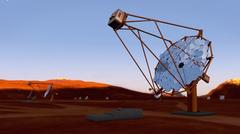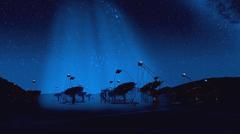Illustration of CTA's Medium Sized Telescope (MST) type for which DESY is in charge. Credit: DESY/Milde Science Communication
The Cherenkov Telescope Array (CTA) will be a ground-breaking new observatory for high-energy gamma rays from the Universe. CTA will be the largest and by far the most sensitive observatory of its kind. The scientific potential of CTA is extremely broad: from understanding the role of relativistic cosmic particles to the search for dark matter. This new instrument will be built with significant contributions from DESY scientists. DESY is responsible for several key components of CTA, among others, for one of three CTA telescope types.
The CTA consortium has just published a detailed description of the key science questions that will be addressed with the observatory. The 200 page document ‘Science with the Cherenkov Telescope Array’ represents two years of work by more than 1200 scientists, with community input from astrophysics, cosmology, and particle physics. The three major scientific questions for CTA are:
1. Understanding the Origin and Role of Relativistic Cosmic Particles
Cosmic rays are highly energetic particles that constantly impinge on Earth’s atmosphere. Their origin and the mechanism by which they are accelerated is at this point not well understood. Cosmic rays also play an important role in the formation and dynamics of galaxies like our Milky Way. Our Universe would look very different without these highly energetic particles. CTA will revolutionize our understanding of cosmic particle accelerators with its unprecedented precision and sensitivity.
2. Probing Extreme Environments
CTA will observe extreme environments in astrophysical objects: strong magnetic and gravitational fields in the vicinity of neutron stars and black holes, and particle acceleration in relativistic plasma jets in the neighbourhood of supermassive black holes. CTA will also study the voids in intergalactic space and probe the development of photon and magnetic fields on cosmic scales.
3. Frontier of Physics
CTA will be the most sensitive instrument at an energy range above 20 gigaelectronvolts to search for elusive dark matter particles. This includes the search for both heavy dark matter candidates predicted by models such as supersymmetry and light candidates such as so-called axion-like particles.
The Science with CTA document describes in detail the observational program defined to address these questions. This includes observations of the galactic plane, distant active galaxies, and short outbursts of highly energetic emission which will be observed in coordination with other observatories.
CTA will consist of two large arrays of telescopes for complete sky coverage: the Northern array with 25 imaging Cherenkov telescopes on the island of La Palma (Spain), and the Southern observatory with a large array of 100 telescopes to be built in the desert near Paranal, Chile.
CTA will be the first open, proposal-driven observatory for gamma rays. It is being developed and built by an international collaboration of institutes from all over the world. CTA’s headquarters are located in Bologna (Italy) and the CTA Science Management Center is hosted by DESY in Zeuthen.
Reference:
„Science with the Cherenkov Telescope Array“; The Cherenkov Telescope Array Consortium; https://arxiv.org/abs/1709.07997









